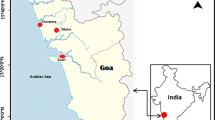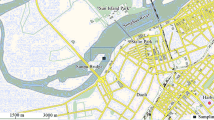Abstract
Heavy metal accumulation in aquatic ecosystems is a common phenomenon among bivalve filter feeders. This study was carried out over an 18-month period at Ada and Aveglo in Ghana, where intense clam fishing represents a major livelihood. The study sought to investigate the concentrations of some heavy metals, zinc, manganese, iron and mercury, in whole soft tissues of three different size classes of the Volta estuary clam, Galatea paradoxa, in relation to geoaccumulation of the metals in benthic sediments. The study also sought to examine whether the levels of the metals in clam tissues were within acceptable limits for human consumption. Clam sizes were categorised as small (25–40 mm) medium (41–55 mm) and large (above 55 mm) based on shell lengths and predominant sizes captured in the Volta estuary. Mercury levels in clams and sediments were determined using a Mercury Analyser while Zn, Mn and Fe were determined using an Atomic Absorption Spectrophotometer. Heavy metal concentrations in clams were within permissible limits with reference to WHO safety standards. There were no significant spatial differences (p>0.05) in the concentrations of Mn, Zn, Fe and Hg in clams at Ada and Aveglo. No relationship was observed between heavy metal concentrations in clams and geo-sediments indicating that metal accumulation in clams may not be directly or solely derived from sediments but from other sources such as dissolved metals in the water and seston. Highly significant differences (p<0.0001) were observed between the clam size-classes and sediment samples for iron. Total mercury concentrations showed highly significant variations (p<0.0001) between all the clam size-classes and the sediment samples.
Similar content being viewed by others
References
Amisah S, Adjei Boateng D, Obirikorang KA, Quagrainie KK (2009) Effects of clam size on heavy metal accumulation in whole soft tissues of Galatea paradoxa (Born, 1778) from the Volta estuary, Ghana. Int J Fish Aquacult 12:014–021
Attipoe FYK, Amoah C (1989) Ecological and economic problems associated with the Volta Dam—the case of the Egeria and Macrobrachium fisheries of the lower Volta. Paper presented at the Ghana National Seminar on Inland Fisheries and Aquaculture, 22–25 August 1989. 20 pp (Mirneo)
Cardoso I, Granadeiro JP, Cabral H (2008) Benthic prey quality in the main mudflat feeding areas of Tagus Estuary: Implications for bird and fish populations. Cienc Mar 34(003):283–296
Chang JS, Yu KC, Tsai LJ, Ho ST (1998) Spatial distribution of heavy metals in bottom sediment of Yenshui river, Taiwan. Water Sci Technol 38(11):159–167
Din ZB (1992) Use of aluminium to normalize heavy-metal data from estuarine and coastal sediments of Straits of Melaka. Mar Pollut Bull 24:484–491
El-Shenawy NS (2002) The effect of metal bioaccumulation on glutathione and lipid perodixation as biomarkers of aquatic ecosystem pollution of Ruditapes decussates and Venerupis pullastra from Lake Timsah, Ismailia. Egypt J Zoology 39:475–492
Etim L, Akpan ER, Muller P (1991) Temporal trends in heavy metal concentrations in the clam E radiata (Bivalvia: Tellinacea Donacidae) from the Cross River, Nigeria. Rev Hydrobiol Trop 24(4):327–333
Ferreira GA, Machado ALS, Zalmon IR (2004) Temporal and spatial variation on heavy metal concentrations in the bivalve Perna perna (LINNAEUS, 1758) on the northern coast of Rio de Janeiro State, Brazil. Braz Arch Biol Technol 47(2):319–327
GESAMP (IMO/FAO/UNESCO/WMO/WHO/IAEA/UN/UNEP Joint Group of Experts on the Scientific Aspects of Marine Pollution) (1982) The health of the oceans. Rep Stud, GESAMP, (15):108 p. and UNEP Reg Seas Rep Stud, (16):108 p
Gold-Bouchot G, Sima-Alvarez R, Zapata-Perez O, Guemez-Ricalde J (1995) Histopathological effects of petroleum hydrocarbons and heavy metals on the American oyster (Crassostrea virginica) from Tabasco, Mexico. Mar Pollut Bull 31:439–445
Gunther AJ, Davis JA, Hardin DD, Gold J, Bell D, Cricks JR, Scelfo G, Stephenson M (1999) Long term bioaccumulation monitoring with transplanted bivalves in the San Francisco Estuary. Mar Pollut Bull 38:170–180
Huanxin W, Lejun Z, Presley BJ (1999) Bioaccumulation of heavy metals in oyster (Crassostrea virginica) tissue and shell. Environ Geol 39(11):234–240
Mackeviciene G, Striupkuviene N, Berlinskas G (2002) Accumulation of Heavymetals Radionuclides in Bottom sediments of Moniroting Streams in Lithuania. Ekologia (Vilnus), Nr 2
Müller G (1979) Index of geoaccumulation in sediments of the Rhine River. Geojournal 2:108
Nasci C, Da Ros L, Campesan G, Van Vleet ES, Salizzato M, Sperni L, Pavoi B (1999) Clam transplantation and stress-related biomarkers as useful tools for assessing water quality in coastal envieronments. Mar Pollut Bull 39:255–260
Odiete WO (1999) Environmental physiology of animals and pollution. Diversified resources Ltd Lagos, 261 pp
Obirikorang K, Adjei Boateng AD, Amisah S (2009) Consumption of the clam, Galatea paradoxa (Born, 1778) in Ghana: human health implications with reference to heavy metals. Water Qual Exposure Health 1:191–201
Olivier F, Ridd M, Klumpp D (2002) The use of transplanted cultured tropical oysters (Saccostrea commercialis) to monitor Cd levels in north Queensland coastal waters (Australia). Mar Pollut Bull 44:1051–1062
Otchere FA (2003) Heavy metals concentrations and burden in the bivalves (Anadara (Senilia) senilis, Crassostrea tulipa and Perna perna) from lagoons in Ghana: model to describe mechanism of accumulation/excretion. Afr J Biotechnol 2(9):280–287
Phillips DJH, Yim WW-S (1981) A comparative evaluation of oysters, mussels and sediments as indicators of trace metals in Hong Kong waters. Mar Ecol Prog Ser 6:285–293
Regoli F (1998) Trace metals and antioxidant enzymes in gills and digestive gland of the Mediterranean mussel Mytilus galloprovincialis. Arch, Environ Contam Toxicol 34:48–63
Sastre J, Sahuquillo A, Vidal M, Rauret G (2002) Determination of Cd, Cu, Pb and Zn in environmental samples: microwave-assisted total digestion versus aqua regia and nitric acid extraction. Anal Chim Acta 462:59–72
Spencer KL, MacLeod CL (2002) Distribution and partitioning of heavy metals in estuarine sediment cores and implications for the use of sediment quality standards
United States Environmental Protection Agency (USEPA) (1994). Sediment sampling. SOP#: 2016
Vazquez GF, Sanchez GM, Virender KS (1993) Trace metals in the oyster Crassostrea virginica of Terminos Lagoon, Campeche, Mexico. Mar Pollut Bull 26(7):398–399
Wang WX, Yan QL, Fan W, Xu Y (2002) Bioavailability of sedimentary metals from a contaminated bay. Mar Ecol Prog Ser 240:23–38
Author information
Authors and Affiliations
Corresponding author
Rights and permissions
About this article
Cite this article
Amisah, S., Obirikorang, K.A. & Adjei Boateng, D. Bioaccumulation of Heavy Metals in the Volta Clam, Galatea Paradoxa (Born, 1778) in Relation to Their Geoaccumulation in Benthic Sediments of the Volta Estuary, Ghana. Water Qual Expo Health 2, 147–156 (2011). https://doi.org/10.1007/s12403-010-0032-5
Received:
Accepted:
Published:
Issue Date:
DOI: https://doi.org/10.1007/s12403-010-0032-5




